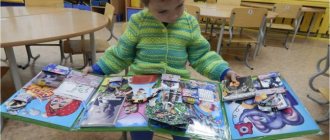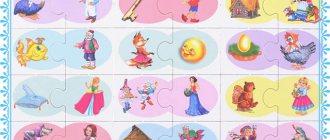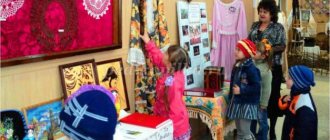PURPOSE AND OBJECTIVES OF ETHNOCULTURAL EDUCATION
Ethnocultural education is aimed
for students to master those national and cultural traditions that embody the highest spiritual and moral values of both individual ethnic groups and all humanity, which are of particular importance for the spiritual and moral education and civic development of modern man, as well as the positive development and consolidation of modern Russian society and its integration into the world community. Such education forms, first of all, a value-based attitude towards the Motherland, towards nature, towards family, home and parents, towards work, towards creativity according to the laws of beauty, towards the cultural heritage and traditions of one’s own and other peoples.
The system of ethnocultural education is designed to help solve several groups of pressing problems
education, training, personality development, as well as its socialization, sociocultural and ethnocultural adaptation and correction.
· The first group of tasks includes the education of the ethnic culture of the individual, including his ethnocultural needs, interests, value orientations, etc. It also includes the tasks of realizing the pedagogical potential of folk culture, folk art as a means of patriotic, moral, aesthetic, labor, environmental personality education as a factor in nurturing a culture of interethnic communication. Ethnic and artistic education is designed to promote in students a sense of national dignity, a culture of interethnic communication through the development of associative creative thinking in the process of mastering the connections of traditional culture and folk art with everyday life, work, the history of the country and the world, through the ability to see historical and cultural monuments in a broad socio-historical context context.
· The second group of tasks is associated with the formation and development of ethnocultural competence of all social and age groups of the population, teaching them basic knowledge, skills and abilities in the field of folk culture, the formation of ideas about universal human values inherent in each specific national culture, with the practical development of draft types of ethnoartistic and ethnopedagogical activities. This group of tasks also includes training personnel for professional activities in the fields of ethnocultural education and folk artistic creativity within the framework of the current university specialty “Folk artistic creativity”, the current direction of higher professional education “Folk artistic culture”, as well as the promising direction of training teachers-ethnoculturologists “ Ethnocultural education”, which must be included in the new classification of specialties.
The third group of tasks is the development of personal qualities of students through ethnocultural education as a factor in the intellectual growth of children and youth, as a means of developing their creative abilities, needs for self-knowledge and self-development, ability for self-actualization, etc. It is also necessary to develop students’ cultural and historical memory, special the quality of thinking and mnemonics in the process of systematic, comprehensive development of folk art with the involvement of works of folk art, not only belonging to domestic diverse regional style traditions, but also created by the peoples of the world. In the process of ethno-artistic education, it is necessary to develop special qualities of aesthetic consciousness, revealing the interaction of national folk art with different areas of professional (classical) art.
· The fourth group of tasks is the need to attract resources of ethnocultural education for the prevention and correction of deviant behavior of the individual, for the prevention of painful addictions in children and adolescents, for their socialization and improvement through, for example, modern methods of folklore therapy and other types of art therapy based on the material and through folk culture and art.
Ethnocultural component in the educational process of a preschool educational institution
Everyone says Motherland. But what do we mean by this word? Where did you grow up? Or where were you born? No, the homeland is not determined by the place of residence and birth. The real Motherland is a place where a person always strives to return, it is a place where a person feels part of this place. The homeland is a piece of the world that we try to preserve, preserve, and protect. This is a place where we are welcome, where we feel good and free.
My native land is songs, games, holidays, ditties, books, language, culture and history, these are the first memories from childhood, this is picturesque Bashkir nature, bright sun, endless blue sky and endlessly beautiful forests. There are many beautiful places in the world, but the most dear and beautiful place for me is my native land. Every person must love and protect his homeland.
We are often not inclined to get acquainted with the past of our native land, its history, past, culture, culture of relationships. As you know, by appreciating and knowing the past of your native land and taking care of the present, you can create the future.
An educated person is interested in history and cultural tradition. He has formed cultural needs: meaningful activity, higher spiritual principles, the desire for morality. He feels belonging to a certain culture and ethnic group.
The study of ethnocultural phenomena is a necessary condition that contributes to the development of ethnocultural education. A large role for the development of ethnocultural education is assigned to educational institutions. Since the most important transmitter of national and world culture are preschool educational institutions.
The need to organize the educational process in preschool educational institutions on an ethnocultural basis was recognized by domestic teachers from the very beginning of their creation in Russia. Ethnocultural historical experience should determine the uniqueness of educational work in preschool educational institutions.
Ethnocultural education is a system in which all goals, technologies and content are aimed at the development and socialization of the child’s personality as a subject of an ethnic group and as a citizen of the multinational Russian state. Ethnocultural education implies the introduction into the educational process of knowledge of native folk culture, the cultivation of friendly attitudes towards people of different nationalities, spiritual and moral values, the history of folk culture, social norms of behavior, familiarization with the cultural achievements of other peoples, the use of the experience of folk education in order to develop children's interest in native culture.
Currently, we have a new attitude towards traditions, holidays, arts and crafts, decorative and applied arts, which we inherited from our ancestors. Therefore, it is important for us to introduce preschool children to the origins of national cultures.
In preschool educational institutions, children are introduced to the history, nature of their native land, culture, acquaintance with their native land, with the past of their native land.
The ethnocultural component permeates life in kindergarten. Accompanies children from the nursery group to the preparatory group. In the form of fairy tales, proverbs, fables and folk games. Children's horizons expand through rituals, holidays and customs.
As a result of this work, children develop their personality, worldview, attitude, moral, social and aesthetic development.
This interesting, rich, alluring and vibrant life will not leave children indifferent.
The ethnocultural component is the path to a national culture. This is a means of reviving beauty, independence, individuality, cognitive activity, and familiarization with the identity of the people.
With the help of ethnocultural education, children develop friendliness, goodwill, and a sense of empathy.
Ethnocultural education is a process in which the goals, objectives, content, and technologies of education are aimed at developing the individual as a subject of an ethnic group and as a citizen of the multinational Russian state.
Ethnocultural education is introduced by introducing knowledge of spiritual and moral values into the educational process, fostering friendly attitudes towards people of different nationalities and cultures, social norms of behavior, knowledge of native folk culture, familiarization with the culture of other peoples, and developing children’s interest in folk culture.
Children attending a preschool educational institution with an ethnocultural component develop more developed cooperation skills and a value-based attitude towards the cultural and historical characteristics of their native land, the formation of professional interest and the desire to further realize themselves in the field of creative, stage or vocal direction; artistic and aesthetic taste develops. Children also have a higher level of cognitive development, learning ability, emotional and aesthetic. This is due to the fact that a preschool educational institution with an ethnocultural component pays great attention to emotional, aesthetic and cognitive development. The groups maintain a favorable environment for the development of the child’s personality; children get acquainted with nature, environmental relationships, cultural and historical knowledge, and works of art. In kindergarten, thanks to the ethnocultural component, a favorable background, which is so necessary for the development of the child’s personality, children are introduced to sculptural knowledge - historical knowledge, folk crafts, works of art, Russian nature, environmental relationships, monuments of literature, fine and musical art. The process of using the means of the ethnocultural component is more effective: theatrical performances, folk games and holidays, ensemble, reading fiction.
Quite high rates of speech development and play in children attending preschool educational institutions with an ethnocultural component of education. This is due to the fact that the speech activity of such children is higher, due to the fact that children often participate in folk games and holidays, in theatrical performances, and in artistic productions.
Principles for introducing an ethnocultural component into the education of preschool children:
- Reliability - ethnocultural information must be reliable;
- Entertaining - the inclusion of an ethnocultural component should evoke interest and an emotional response, satisfying the need to know oneself and the world around us;
- Accessibility - information must be accessible to children of a certain age and have a clear logic of presentation;
- Variability - the information presented must allow for variability of points of view, based on arguments, evidence, and include anti-stereotypical elements;
- Complexity - educational material is presented by different means: demonstrations, verbal story, conversation, visual illustrations, practical experiments, organization of observation, research activities, demonstration of a method of action. As a result, children can receive information at the auditory, visual and muscular levels of perception;
- Polyartism - involves the child’s participation in various types of creative activities and learning many types of crafts;
- Egocentricity - the information provided must affect the interests of the child, satisfy his needs in the ethnocultural sphere, be significant for him, contribute to his self-development, self-awareness and self-improvement;
- The principle of continuity and consistency in the study of cultures. It is important to understand that children cannot fully understand all the many ethnic cultures of Russia and the world. First of all, children should have a good knowledge of the culture of their people and region.
The ethnocultural component increases the effectiveness of the educational process of a preschool institution.
From pedagogical experience it is known that an important component for creating high opportunities for education in the conditions of the ethnocultural component is the interrelation and unity of public and family education.
Successful and high performance of the educational process depends on the cooperation between children, teachers and parents. To successfully form cooperation, it is important to imagine the team as a big close-knit family. It is also necessary to organize joint activities.
This contributes to the establishment of mutual understanding between teachers, children and parents, unity, and the creation of a favorable climate in the family and in the educational preschool institution.
Accordingly, it is reasonable to organize a joint part of the work with children and parents, solving assigned tasks and problems together. Join efforts to achieve high results without infringing on each other's interests.
A partnership between parents and teachers makes it possible to better choose an approach to a child, look at him from different angles, establish contact in different situations, and consequently help parents understand the individual characteristics of the child, as well as successfully overcome possible difficulties in upbringing.
Forms and methods of developing children’s ethnocultural awareness
Preschool childhood is an important stage in the development of a person’s moral character. During these years, children lay the foundations of morality and form initial ethical ideas.
The preschooler intensively enters the social world, sensitive and inquisitive. Of great importance in the socialization of a preschooler is the cultivation of respect for the fundamentals of the culture of other peoples, in other words, ethnocultural awareness, or recognition of the diversity of the cultural heritage of other peoples as the norm.
I believe that the success of developing ethnocultural awareness depends on the forms and methods of training and education.
These forms include the following:
1. Cycles of integrated classes, including various types of activities: educational, artistic, visual, musical, gaming based on a single content. In accordance with the topic of the lesson, I determine the dominant type of activity: in one case it can be constructive activity, in another - musical, in the third - cognitive.
At the same time, there are topics where different types of activities are equivalent! For example, in a lesson on speech development on the topic “Holidays of the Peoples of the World,” children will learn what holidays different nations have and how they celebrate them. During the drawing and design class, holiday attributes are made and decorated. In music, they learn songs and round dance games. At physical education classes, they get acquainted with the outdoor games of different nations, and as a result, everything is included in the fun with the children.
2. I conduct cognitive, ethical, heuristic conversations in classes and in my free time, for example, during the morning reception of children or walks, based on:
- children's knowledge about life in the family, because each family has its own national way of life;
- observations, during excursions and leisure activities, which help to acquire knowledge in the field of culture of different peoples and interethnic communication.
3. I use video viewings in classes and in my free time in the afternoon. Video materials include specially created educational programs or recordings of popular television programs on relevant topics. Video viewings allow, firstly, children to create dynamic visual images of the life and activities of different peoples; secondly, to broaden their horizons - preschoolers gain ideas about those events, phenomena, objects that they cannot directly perceive: about historical facts, about the life and architecture of peoples living in different parts of the Earth, about the work of adults in their native land, etc.
4. Entertainment and holidays with ethnocultural and state themes give children a colossal emotional charge and sharpen observation and perception, enrich sensory experience, and therefore form a genuine interest in ethnocultural phenomena. Every year we spend with children: among the Russian people: Christmas, Maslenitsa, Easter; among the Tatar people: Navruz, Kurban Bayram, Sabantuy.
5. Folklore concerts and theatrical performances are organized with the participation of teachers, children and their parents, providing an opportunity to plunge into another ethnoculture, to be in the image of a representative of another nationality. Concerts in which songs, dances, and playing musical instruments can be dedicated to one topic (for example, celebrating calendar holidays), or can be combined (held at the end of the school year as a final concert). In turn, the scripts for theatrical performances are based on folk tales or original stories that reflect ethnocultural specifics. They can reproduce calendar and family holidays with accompanying folklore rituals, reflect certain ethnographic realities (for example, staging gatherings, receiving guests, work activities, etc.).
6. Targeted walks and excursions ensure that children get to know the social, cultural and natural diversity of their native land; we visit: libraries, a puppet theater, an art gallery, a museum, monuments, parks. The objectives of this type of activity are to activate existing knowledge, enrich experience, and help the child acquire objective ideas and knowledge about ethnic communities and their culture outside of class.
On walks, I invite children to check folk signs, guess a riddle, find confirmation of a saying, and focus on the features of the landscape, climate, and natural phenomena inherent in Tatarstan and its geographic latitude. This will allow children to get live impressions and acquire fairly generalized knowledge of local history.
Excursions, visits to exhibitions, museums and other cultural sites contribute not only to expanding knowledge about the local environment, but also to acquiring new information about the realities of other ethnic worlds and natural environments, about the peculiarities of the way of life and culture of other peoples.
Let us now dwell on the methods and techniques of intensifying the process of forming ethnocultural awareness of children:
1. Game methods and techniques arouse increased interest and positive emotions in children, promote concentration on the educational task, which becomes not imposed, but its own personal goal. Using various didactic, role-playing, active, and constructive games, we organically and purposefully introduce children to the world of folk culture and the ethics of human relations. Such games include: folk active and comic games with peers and adults, folk jokes and counting rhymes.
For example, to identify the level of awareness of children, we use games like “Edible - inedible”, “Antique - non-antique” (used in the past and in the present tense: bast shoes - shoes, braid - shirt, washboard - car, etc.) These games can be carried out as sedentary games (the teacher names the word, and the children, depending on what culture, what period of time, etc. it can be attributed to, crouch or clap their hands, catch or throw the ball) or as didactic games (by such as “Wonderful bag”, “Find the mistake”, “Select what you need”, etc.).
2. The method of imaginary situations (place, roles, equipment, actions) increases the degree of assimilation of cognitive material.
For example, I suggest imagining that children are in the forest, on a desert island, some kind of republic, etc.; imitate substitute things; They flew like birds, galloped like horsemen.
3. The game-travel method is used to clarify children's knowledge.
4. The surprise moment method helps to activate the emotionality of children. For example, a parcel arrived with gifts, performing various game actions (for example, playing a folk outdoor game), playing roles (the teacher appears in the image of the mistress of a Russian hut or in the image of a representative of another nationality), etc.
5. Verbal method.
- A valuable technique is comparison, which allows us to identify the general and special in the historical development and cultures of different peoples of the world, the reasons for these similarities and differences. So, children can be offered grouping and classification tasks. “Arrange the pictures into two groups: in one - everything that can be attributed to Russian culture (things, household items and art, culinary dishes, fairy-tale characters and other symbols), and in the other - everything related to Tatar culture.”
- Reception developmental questions. During such a conversation, I pose questions, encourage children - on the basis of observations, personal experience, ideas, previously acquired knowledge - to compare, contrast individual facts, phenomena inherent in ethnic cultures, and then, through reasoning, draw conclusions, highlighting something common, special or unique in the cultures of different peoples.
6. Modeling and design method combining verbal explanation, practical implementation and game motivation. This method is indispensable when working with the globe, with diagrams and maps. In addition, each child has a notebook-album in which, with the help of signs, symbols, drawings, he reflects everything that he learned in class, excursion and what he liked.
7. The project method involves organizing joint research activities of children and their parents in collecting, studying, analyzing, and then presenting materials that reveal the characteristics of traditions, lifestyles, household items, and art of different peoples.
Research topics are proposed by teachers in accordance with the thematic plan, or chosen independently by family members. Here are the topics of some research projects: “The image of Baba Yaga in Slavic fairy tales,” “The purpose of a towel in peasant life,” “Tea drinking ceremony,” “Genealogy of my family,” etc. All of the above methods are used by teachers in different organizational forms and types of activities.
The art of teachers lies in the skillful combination of methods and techniques, in their logical correlation with the form, place of use, age and individual characteristics of the pupils.
When introducing children to national heritage, parents play a huge role. It is in the family that children receive their first ideas about the culture of their people, and respect for representatives of other cultures and for these cultures themselves is formed.
Using the family's potential is carried out by:
- involving parents in conducting classes (introducing children to the customs of the peoples of which they themselves are representatives, or teaching them some craft or skill with ethnocultural specifics: embroidery, wicker weaving, wood burning, playing a folk musical instrument);
- participation of parents in exhibitions of family creativity;
- arranging presentations of national rarities and family traditions;
- provision by parents of photographs, albums, brochures, video materials of household items and art kept by the family or brought from travel.
- creating a mini-museum of family collections in a group room;
- parents conducting walks and excursions along routes proposed by the teacher;
- joint participation with children in a folklore concert, performance or entertainment with ethnocultural themes;
- conducting research activities with children (project method) with further presentation of its results in the educational process.
During the work, we introduced the children to their hometown and the peoples living in it; geographical location, history and folk applied art of the peoples of the Volga region.
As a result of this work, the children learned to love their city, their native nature, and treat it with care. Communication with nature and the origins of the culture of the peoples of the Volga region ennobles a person and allows him to more fully experience the beauty of life. Children became observant, inquisitive, their speech was enriched, their horizons expanded, and their relationships with their parents became closer.
In the future, we plan to continue the work we have begun in ethnocultural awareness of children.




